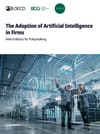📌 What’s Covered
This report offers one of the most detailed, empirical snapshots of AI adoption in firms to date, merging survey results, case studies, and institutional interviews. Its heart is the 2022–2023 OECD/BCG/INSEAD Survey of AI-Adopting Enterprises, which spans G7 economies and Brazil. The findings are sorted into six major chapters that span diffusion trends, barriers, firm-level use cases, public-private collaboration, and institutional ecosystems.
A few standouts:
- AI diffusion is uneven: While large firms lead adoption, small and medium enterprises (SMEs) trail due to limited resources, lack of data maturity, and a vague understanding of AI’s benefits.
- Cloud underutilisation is common, not because of technical constraints but due to cost concerns, unclear ROI, and regulatory uncertainty.
- Talent gaps remain acute: Many firms struggle to define AI-relevant roles and skills. Academic credentials aren’t enough—firms want clearer qualification frameworks and more practice-based training.
- Public-private partnerships matter: Collaborations with universities, data initiatives, and training programmes are highly valued. However, businesses want these interactions to be simpler, more transparent, and tailored to real-world AI applications.
- Dedicated public institutions help: Examples include “diffusion institutions” that provide proofs of concept, matchmaking, or vendor guidance. But they often reach too few firms to generate system-wide impact.
- Policy clarity is a major concern: Enterprises express strong support for regulation that provides clear lines of accountability when AI is deployed.
The report doesn’t just report numbers—it connects those findings with recommendations, often highlighting where government intervention is working and where it’s falling short. It also includes rich data appendices that could easily inform national AI strategies, particularly around education, workforce upskilling, and SME engagement.
💡 Why it matters?
This isn’t just another AI hype report—it’s grounded in what firms are actually doing. That makes it especially relevant for policymakers and governance professionals trying to understand where AI policy can offer the most leverage. Whether you’re setting up AI training initiatives, rethinking industrial policy, or designing SME support programmes, this report gives you the data you need to act—not just speculate.
⚠️ What’s Missing
Despite its strength, the report leans heavily on self-reported data and high-level overviews. It doesn’t fully explore how power asymmetries between AI vendors and adopters shape the pace of adoption, or how geopolitical pressures (e.g. export controls or regulatory fragmentation) impact enterprise strategies. It also mostly avoids ethical or safety considerations, which may be beyond scope but are increasingly important as firms automate sensitive processes. More intersection with governance risks would have made this even stronger.
👍 Best For
Ideal for policymakers, AI ecosystem builders, economic analysts, and anyone working in public sector innovation or technology diffusion. It’s especially helpful for designing support mechanisms for SMEs and understanding the real bottlenecks in workforce upskilling. Also useful for national AI strategy teams seeking internationally comparable metrics and benchmarks.
📚 Source Details
Title: The Adoption of Artificial Intelligence in Firms: New Evidence for Policymaking
Authors: OECD, Boston Consulting Group (BCG), INSEAD
Year: 2025
Link: https://doi.org/10.1787/f9ef33c3-en
Type: Survey report with institutional case studies
Commissioned by: OECD AI-WIPS, supported by the Government of Germany


